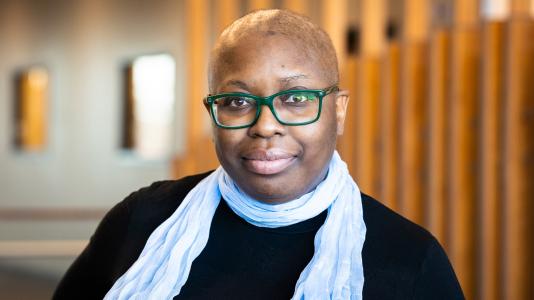Meet Leighanne C. Gallington, Beamline Scientist
Providing expert support for scientists visiting Argonne’s Advanced Photon Source

From her vantage point at Sector 1 at the Advanced Photon Source (APS), Beamline Scientist Leighanne Gallington appreciates her panoramic view of the science that she is conducting, supporting and shaping. The APS is a U.S. Department of Energy’s (DOE) Office of Science User Facility at DOE’s Argonne National Laboratory.
As a member of the X-ray Science division’s Materials Physics and Engineering group, Leighanne supports outside users who visit Argonne from all over the world. “The scientists who come to the APS are experts in their fields. Some are also knowledgeable about X-ray experimental techniques, but others, especially graduate students, are less familiar with what we can deploy at the APS to help them test their hypotheses. That’s where I step in.”
This knack for probing material’s properties at the APS actually began when she was pursuing her doctorate at Georgia Tech: her focus was on studying negative thermal expansion materials, which shrink when heated — the opposite of most materials. With one family of these materials, zirconium tungstate, Leighanne’s question was: What happens if we also apply pressure?
But answering that question required more powerful X-rays than available at a regular laboratory, so Leighanne found herself at the APS, where she discovered new behaviors and an alternate phase in the material — findings that were not in the existing literature — and she published her results.
During several trips to the APS to obtain the measurements for these studies, she also helped fellow students on their experiments. As she closed in on finishing her Ph.D., she found and applied for a postdoc opening at Argonne and was hired in 2015. Leighanne transitioned to full-time staff in 2018, and now works on many engineering-based problems at Sector 1.
In fact, one large team’s experiment exemplifies her contributions in her current role. This team’s project involved enhancing the performance of catalysts, which are active at their surfaces only.
Leighanne realized that their planned method would drive the test materials to less-optimal areas of the catalyst’s structure, where the experiment would deliver less catalytic “bang for the buck.” She demonstrated this outcome directly to the research team using experimental techniques available at the beamline; density functional theory later confirmed the underlying mechanism. For this kind of expertise and active engagement, Leighanne has been acknowledged as a co-author by a number of research teams using the APS.
Throughout what she describes as the “winding path” of her science career, Leighanne credited her parents as her heroes.
Her father, an electrical engineer, modeled tenacity. Before starting at MIT, he leapt into its Interphase Preparatory Program, attending every office hour available and excelling once he started regular classes, also inspiring Leighanne’s undergraduate studies at MIT.
Her mother, now a highly regarded investigator of complaints against attorneys for the Massachusetts Board of Bar Overseers, made many sacrifices. These included enabling Leighanne and her brothers to participate in numerous extracurricular academic programs, as well as the Metropolitan Council for Educational Opportunity program, a voluntary school integration initiative in Massachusetts.
Together, her parents ensured that she stayed challenged in high school at the Boston Latin School, Benjamin Franklin’s alma mater, where she graduated as a Franklin medal awardee and was usually the only African American student in her classes.
All of these opportunities have helped Leighanne build out a substantial network, an asset that “so many blacks and underrepresented minorities simply don’t have.”
Leighanne’s myriad experiences highlight her effectiveness in her current role. And the payback? “I get to see the whole spectrum of science and the many other scientific problems that people are trying to solve.”
About the Advanced Photon Source
The U. S. Department of Energy Office of Science’s Advanced Photon Source (APS) at Argonne National Laboratory is one of the world’s most productive X-ray light source facilities. The APS provides high-brightness X-ray beams to a diverse community of researchers in materials science, chemistry, condensed matter physics, the life and environmental sciences, and applied research. These X-rays are ideally suited for explorations of materials and biological structures; elemental distribution; chemical, magnetic, electronic states; and a wide range of technologically important engineering systems from batteries to fuel injector sprays, all of which are the foundations of our nation’s economic, technological, and physical well-being. Each year, more than 5,000 researchers use the APS to produce over 2,000 publications detailing impactful discoveries, and solve more vital biological protein structures than users of any other X-ray light source research facility. APS scientists and engineers innovate technology that is at the heart of advancing accelerator and light-source operations. This includes the insertion devices that produce extreme-brightness X-rays prized by researchers, lenses that focus the X-rays down to a few nanometers, instrumentation that maximizes the way the X-rays interact with samples being studied, and software that gathers and manages the massive quantity of data resulting from discovery research at the APS.
This research used resources of the Advanced Photon Source, a U.S. DOE Office of Science User Facility operated for the DOE Office of Science by Argonne National Laboratory under Contract No. DE-AC02-06CH11357.
Argonne National Laboratory seeks solutions to pressing national problems in science and technology by conducting leading-edge basic and applied research in virtually every scientific discipline. Argonne is managed by UChicago Argonne, LLC for the U.S. Department of Energy’s Office of Science.
The U.S. Department of Energy’s Office of Science is the single largest supporter of basic research in the physical sciences in the United States and is working to address some of the most pressing challenges of our time. For more information, visit https://energy.gov/science.